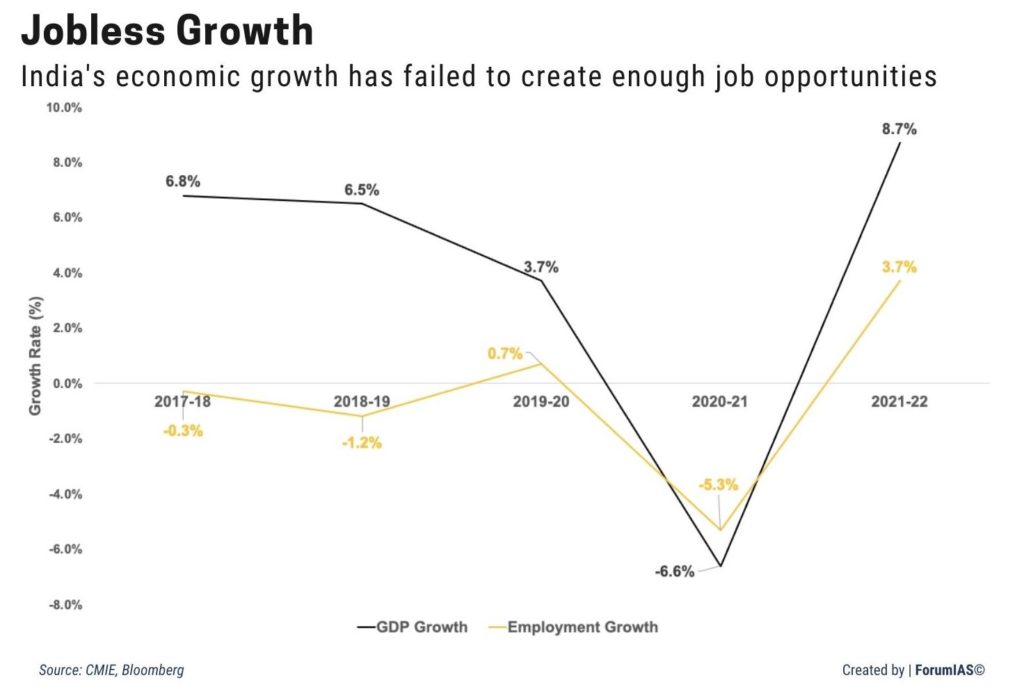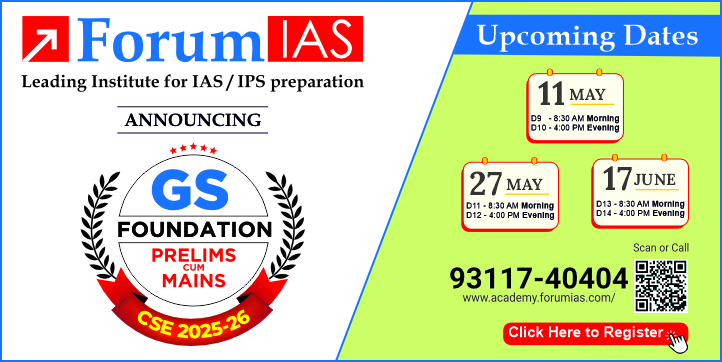ForumIAS announcing GS Foundation Program for UPSC CSE 2025-26 from 19 April. Click Here for more information.
As per OECD (Organisation for Economic Co-operation and Development), inclusive growth is economic growth that is distributed fairly across society and creates opportunities for all.
UNDP described it as “the process and the outcome where all groups of people have participated in growth and have benefited equitably from it”.
Put simply, it refers to economic development that benefits all segments of society, ensuring equitable opportunities and outcomes for individuals regardless of their socio-economic background or circumstances.
What are the Major Components of Inclusive Growth?
1) Reduced Poverty- Inclusive growth strives to reduce poverty by improving the poor’s access to opportunities and resources.
2) Women’s Empowerment- Since women are frequently left out of economic possibilities, inclusive growth aims to provide them more power through employment, education, and training.
3) Good Governance- Transparency, accountability, and efficient institutions that meet the demands of all citizens are essential for inclusive progress.
4) Education & Skill Development- Building skills is a crucial component of inclusive growth because it paves the way for people to engage fully in the economy.
5) Equal Opportunity- Inclusive growth works to level the playing field for everyone, regardless of socio-economic position, gender, race, or religion.
6) Access to Basic Services- Inclusive growth seeks to guarantee that all citizens have access to basic services including healthcare, education, and sanitation. This access should include not only the quantity, but also quality, of these basic services.
7) Employment Creation- To combat poverty and advance economic development, inclusive growth aims to increase employment, especially for disadvantaged and marginalised people.
8) Addressing the Marginalised- Ensuring participation from all sections of society in the social, economic and political sphere.
9) Reduction in Income Disparities- Among the following:
a. Sections of society (Religion, Caste, etc.)
b. Rural-Urban Areas
c. Genders
What is the situation of inclusive growth in India?
India is now one of the fastest-growing economies globally. However, this growth has not resulted in a corresponding increase in its Human Development Index (HDI). According to the Human Development Report of 2021-22, India ranks 132 out of 191 countries.
In the Inclusive Development Index (IDI), 2018 compiled by the World Economic Forum (WEF), India ranked 62nd out of 74 emerging countries and was among the least inclusive countries in G20 countries.
The “Public good or Private Wealth?” Report 2019, published by OxFam showed that India’s top 10% holds 77.4% of the total national wealth, while the top 1% holds 51.53% of the wealth. The bottom 60% of the population holds only 4.8% of the national wealth.
What are the reasons behind lack of Inclusive Growth in India?
1) Historical reasons- Discrimination against certain sections of the society since historic times has affected their access to opportunities and to education, employment and health. Affirmative policies have been restricted to a few beneficiaries.
2) Gender Inequality- Females are treated as subordinate to males. Girl education is considered a burden on the family and women have limited choices in employment.
3) Large-scale informal employment– 80% of the Indian labour force is employed in the informal sector. Informal sector jobs are more insecure without regular pay and social security benefits. This increases the wage gap between formal and informal sectors.
4) Overdependence on Agriculture- A huge proportion of the population is still dependent on agriculture (~45% of the workforce) but the share of agriculture to the total GDP is falling.
5) Regional Disparities in Growth- Growth has been different across sectors and regions. For example, Green Revolution has disproportionately benefitted North-Western India when compared to Eastern India.
6) Globalisation- Studies show that globalization and opening up the economy has benefited the rich more than the poor, thus raising inequality.
7) Jobless Growth- India experienced job growth of 3% p.a in the 70s at a time when the economy grew at 3-3.5% p.a but over the last 3 decades the economy grew at over 5-8% p.a but job growth has been close to 1% p.a.

8) Government Inefficiencies- This includes corruption, maladministration, red tapism etc. This prevents the optimum utilization of resources and creation of jobs.
| Read More- Inclusive Growth |
What are the challenges in ensuring inclusive growth?
1) Poverty- The Multidimensional Poverty Index 2022 places India first, with an estimated 23 crore people living in multidimensional poverty.
2) Uneven Distribution of Resources- Unfair resource allocation can thwart efforts to create inclusive growth. Examples of unfair resource distribution include wealth, land, and education.
3) Social and cultural obstacles- Marginalised groups may encounter social and cultural obstacles that restrict them from accessing opportunities and services, such as discrimination, exclusion, and gender inequity. For instance, Women often face barriers in accessing education, employment, and other opportunities.
4) Weak institutional capacity- Policies and programmes aimed at promoting equitable growth may be less effective if there is a lack of proper implementation, infrastructure, functionaries, etc.
5) Rural-Urban Divide- Disparities between urban and rural areas persist in terms of infrastructure, access to education, healthcare, and employment opportunities. This gap has still not been bridged.
6) Unemployment and Underemployment- Creating enough jobs for the growing workforce, especially in sectors that absorb a large number of people like agriculture and manufacturing, remains a challenge. Many are employed in the informal sector without job security or proper benefits.
7) Education and Skills Gap- Access to quality education and skill development is uneven across regions and socio-economic groups. This leads to a lack of skilled workers and limits opportunities for many individuals.
What are the advantages of inclusive growth?
Ensuring inclusive growth leads to many advantages that positively impact both society and the economy. Some key advantages include:
1) Economic Stability and Sustainability- Inclusive growth contributes to economic stability by creating a more balanced distribution of wealth. When more people have access to resources and opportunities, it can lead to a more sustainable economic development trajectory.
2) Social Cohesion and Stability- Addressing disparities fosters a more cohesive society. It reduces social tensions arising from inequality, which can lead to a more stable and harmonious community.
3) Increased Human Capital Development- When marginalized groups have access to education and skill development, it enhances the overall human capital of the nation. Educated and skilled individuals contribute more effectively to economic growth and innovation.
4) Expanded Consumer Base- Inclusive growth expands the consumer base by bringing more people into the formal economy. This leads to increased demand for goods and services, spurring economic growth.
5) Enhanced Political Stability- When people feel included in the economic and social fabric of society, it often translates to more stable political environments, reducing the risk of social unrest or conflicts.
6) Greater Innovation and Creativity- Inclusive growth brings together diverse perspectives, fostering innovation and creativity. A diverse workforce and society can generate new ideas and solutions to complex problems.
What should be the Way Forward?
Achieving inclusive growth in India requires a comprehensive and multi-dimensional approach. Here are the steps that can be taken to ensure inclusive growth:
1) Education and Skill Development- Improving access to quality education for all, especially in rural and marginalized areas, is crucial. Emphasizing skill development programs that align with market needs can enhance employability.
2) Employment Generation- Encouraging sectors that create more jobs, such as manufacturing, services, and entrepreneurship, can help reduce unemployment and underemployment.
3) Social Protection Programs- Strengthening and expanding social safety nets like the Mahatma Gandhi National Rural Employment Guarantee Act (MGNREGA), subsidized food programs, and healthcare initiatives can provide a safety net for vulnerable populations.
4) Financial Inclusion- Expanding access to banking and financial services, especially in rural areas, can empower individuals and small businesses. Initiatives like Jan Dhan Yojana and Microfinance Institutions can play a significant role here.
5) Gender Equality- Promoting gender equality through policies that support education, employment, and entrepreneurship for women can unlock significant economic potential.
6) Rural Development- Focusing on agriculture by modernizing techniques, providing better access to markets, and improving infrastructure can spur growth in rural areas.
7) Policy Reforms- Implementing policies that promote inclusive growth, such as progressive taxation, land reforms, labour reforms, and policies targeting marginalized communities, can play a pivotal role.
A holistic approach that addresses these multiple dimensions while considering regional disparities and the diverse needs of the population will be key in moving India toward a path of inclusive growth. Collaboration between government, private sector, civil society, and international organisations is crucial in executing these strategies effectively.
| Read More- The Hindu UPSC Syllabus- GS-3- Inclusive Growth |




